lock CHEVROLET CAMARO 2001 4.G Owners Manual
[x] Cancel search | Manufacturer: CHEVROLET, Model Year: 2001, Model line: CAMARO, Model: CHEVROLET CAMARO 2001 4.GPages: 363, PDF Size: 2.75 MB
Page 4 of 363

Table of Contents
Windows
Keys and Door Locks
Keyless Entry System (Option)
Hatch
Automatic Transmission
Manual Transmission
Parking Brake
Tilt Wheel
Turn Signal/Multifunction LeverWindshield Wipers
Cruise Control
Exterior and Interior Lamps
Mirrors
Storage Compartments
Cargo Cover
Accessory Power Outlet
Instrument Panel, Warning Lights and Gages Seats and Seat Controls
Safety BeltsAir Bag System
Restraint Systems for Children
Section
1
Section
2
Seats and Restraint Systems
Features and Controls
ii
Page 5 of 363
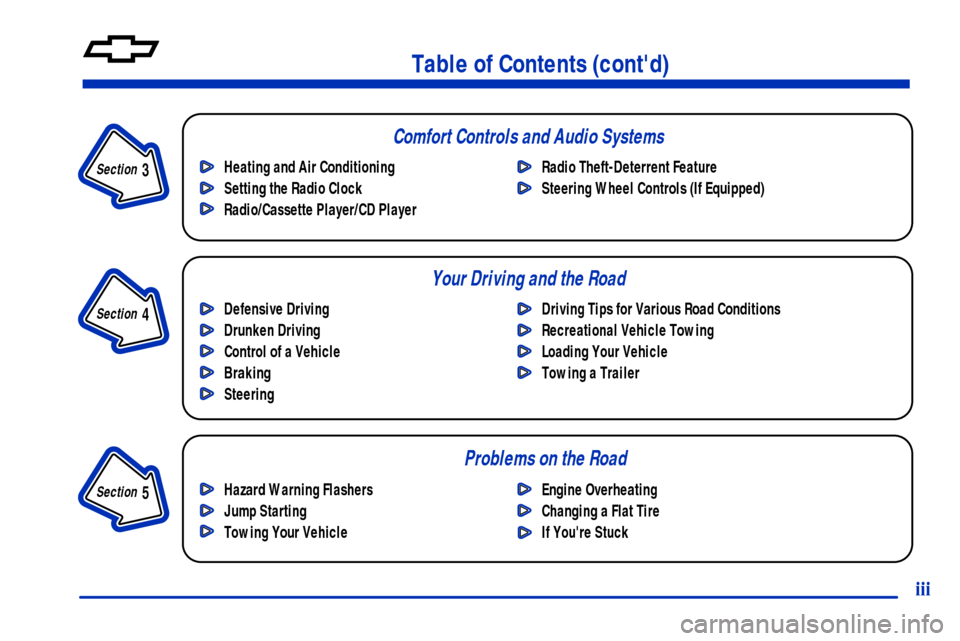
Table of Contents (cont'd)
Defensive Driving
Drunken Driving
Control of a Vehicle
Braking
SteeringDriving Tips for Various Road Conditions
Recreational Vehicle Towing
Loading Your Vehicle
Towing a Trailer Heating and Air Conditioning
Setting the Radio Clock
Radio/Cassette Player/CD PlayerRadio Theft-Deterrent Feature
Steering Wheel Controls (If Equipped)
Hazard Warning Flashers
Jump Starting
Towing Your VehicleEngine Overheating
Changing a Flat Tire
If You're Stuck
Problems on the Road
iii
Section
3
Section
4
Section
5
Comfort Controls and Audio Systems
Your Driving and the Road
Page 11 of 363
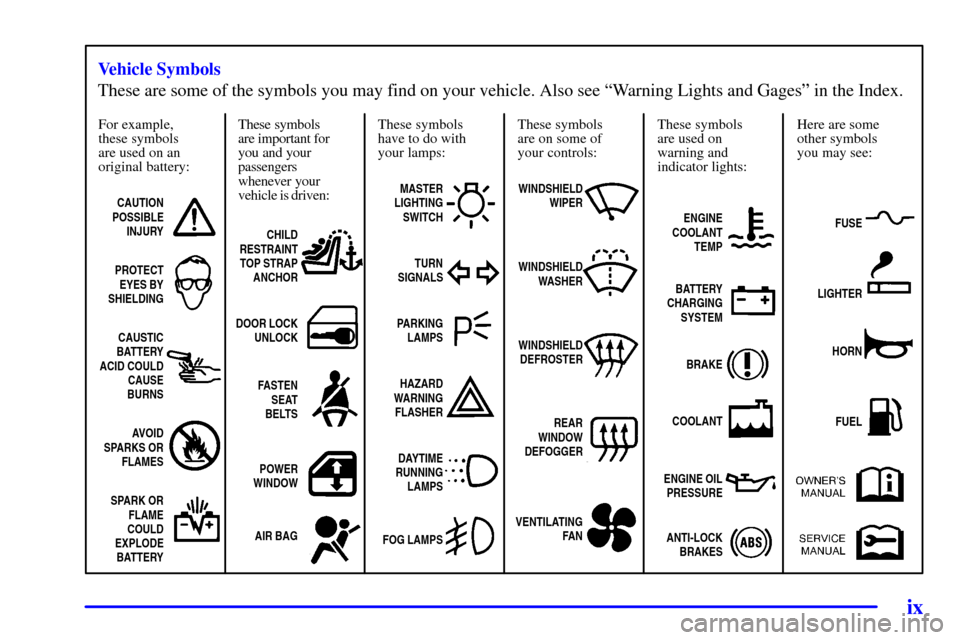
ix
For example,
these symbols
are used on an
original battery:
CAUTION
POSSIBLE
INJURY
PROTECT
EYES BY
SHIELDING
CAUSTIC
BATTERY
ACID COULD
CAUSE
BURNS
AVOID
SPARKS OR
FLAMES
SPARK OR
FLAME
COULD
EXPLODE
BATTERY
These symbols
are important for
you and your
passengers
whenever your
vehicle is driven:
CHILD
RESTRAINT
TOP STRAP
ANCHOR
DOOR LOCK
UNLOCK
FASTEN
SEAT
BELTS
POWER
WINDOW
AIR BAG
These symbols
have to do with
your lamps:
MASTER
LIGHTING
SWITCH
TURN
SIGNALS
PARKING
LAMPS
HAZARD
WARNING
FLASHER
DAYTIME
RUNNING
LAMPS
FOG LAMPS
These symbols
are on some of
your controls:
WINDSHIELD
WIPER
WINDSHIELD
WASHER
WINDSHIELD
DEFROSTER
REAR
WINDOW
DEFOGGER
VENTILATING
FAN
These symbols
are used on
warning and
indicator lights:
ENGINE
COOLANT
TEMP
BATTERY
CHARGING
SYSTEM
BRAKE
COOLANT
ENGINE OIL
PRESSURE
ANTI-LOCK
BRAKES
Here are some
other symbols
you may see:
FUSE
LIGHTER
HORN
FUEL
Vehicle Symbols
These are some of the symbols you may find on your vehicle. Also see ªWarning Lights and Gagesº in the Index.
Page 14 of 363
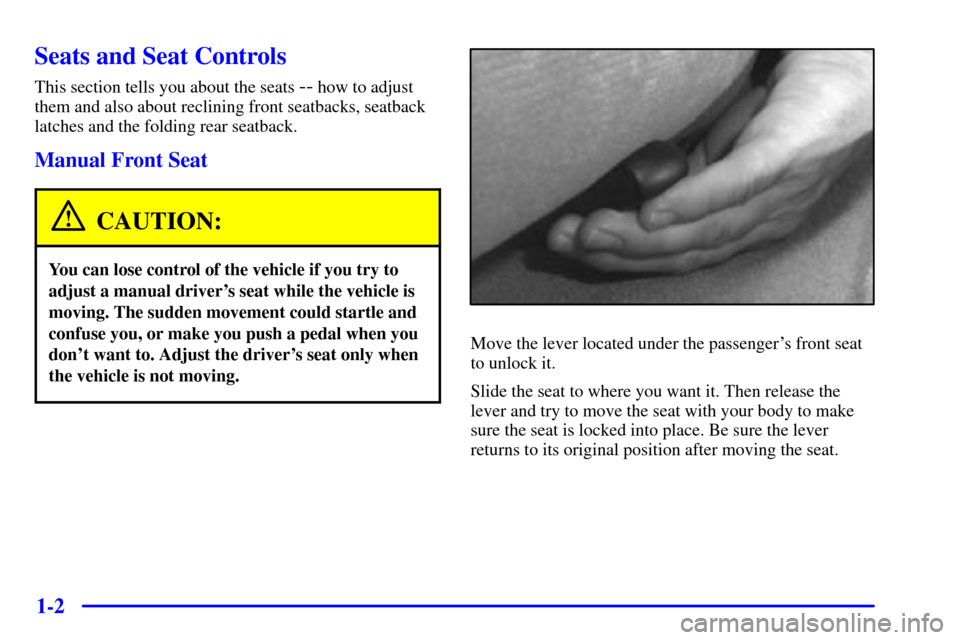
1-2
Seats and Seat Controls
This section tells you about the seats -- how to adjust
them and also about reclining front seatbacks, seatback
latches and the folding rear seatback.
Manual Front Seat
CAUTION:
You can lose control of the vehicle if you try to
adjust a manual driver's seat while the vehicle is
moving. The sudden movement could startle and
confuse you, or make you push a pedal when you
don't want to. Adjust the driver's seat only when
the vehicle is not moving.
Move the lever located under the passenger's front seat
to unlock it.
Slide the seat to where you want it. Then release the
lever and try to move the seat with your body to make
sure the seat is locked into place. Be sure the lever
returns to its original position after moving the seat.
Page 15 of 363
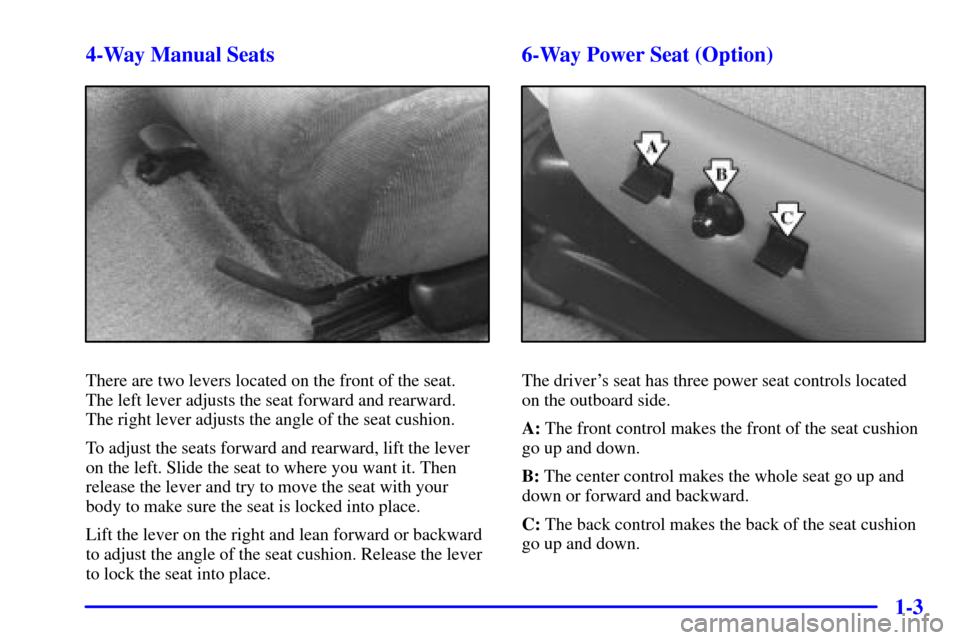
1-3 4-Way Manual Seats
There are two levers located on the front of the seat.
The left lever adjusts the seat forward and rearward.
The right lever adjusts the angle of the seat cushion.
To adjust the seats forward and rearward, lift the lever
on the left. Slide the seat to where you want it. Then
release the lever and try to move the seat with your
body to make sure the seat is locked into place.
Lift the lever on the right and lean forward or backward
to adjust the angle of the seat cushion. Release the lever
to lock the seat into place.
6-Way Power Seat (Option)
The driver's seat has three power seat controls located
on the outboard side.
A: The front control makes the front of the seat cushion
go up and down.
B: The center control makes the whole seat go up and
down or forward and backward.
C: The back control makes the back of the seat cushion
go up and down.
Page 16 of 363

1-4 Reclining Front Seatbacks
To adjust the seatback, lift the lever located on the
outboard side of the seat. Release the lever to lock the
seatback where you want it. Pull up on the lever and
the seat will go to its original upright position.But don't have a seatback reclined if your vehicle
is moving.
Page 17 of 363

1-5
CAUTION:
Sitting in a reclined position when your vehicle is
in motion can be dangerous. Even if you buckle
up, your safety belts can't do their job when
you're reclined like this.
The shoulder belt can't do its job. In a crash you
could go into it, receiving neck or other injuries.
The lap belt can't do its job either. In a crash the
belt could go up over your abdomen. The belt
forces would be there, not at your pelvic bones.
This could cause serious internal injuries.
For proper protection when the vehicle is in
motion, have the seatback upright. Then sit
well back in the seat and wear your safety
belt properly.
Front Seatback Latches
The front seatbacks fold
forward to let people get
into the back seat. To fold
a seatback forward, lift the
latch located on the lower
backside of the seatback.
When you return the seatback to its original position,
make sure the seatback is locked. The latch must be
down for the seat to work properly.
CAUTION:
If the seatback isn't locked, it could move
forward in a sudden stop or crash. That could
cause injury to the person sitting there. Always
press rearward on the seatback to be sure it
is locked.
Page 18 of 363
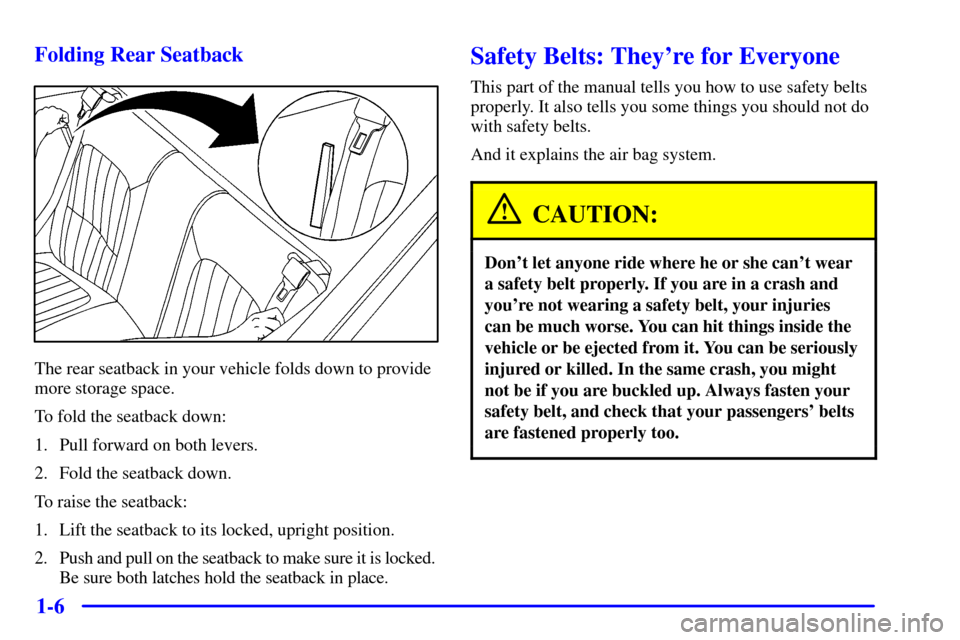
1-6 Folding Rear Seatback
The rear seatback in your vehicle folds down to provide
more storage space.
To fold the seatback down:
1. Pull forward on both levers.
2. Fold the seatback down.
To raise the seatback:
1. Lift the seatback to its locked, upright position.
2. Push and pull on the seatback to make sure it is locked.
Be sure both latches hold the seatback in place.
Safety Belts: They're for Everyone
This part of the manual tells you how to use safety belts
properly. It also tells you some things you should not do
with safety belts.
And it explains the air bag system.
CAUTION:
Don't let anyone ride where he or she can't wear
a safety belt properly. If you are in a crash and
you're not wearing a safety belt, your injuries
can be much worse. You can hit things inside the
vehicle or be ejected from it. You can be seriously
injured or killed. In the same crash, you might
not be if you are buckled up. Always fasten your
safety belt, and check that your passengers' belts
are fastened properly too.
Page 24 of 363
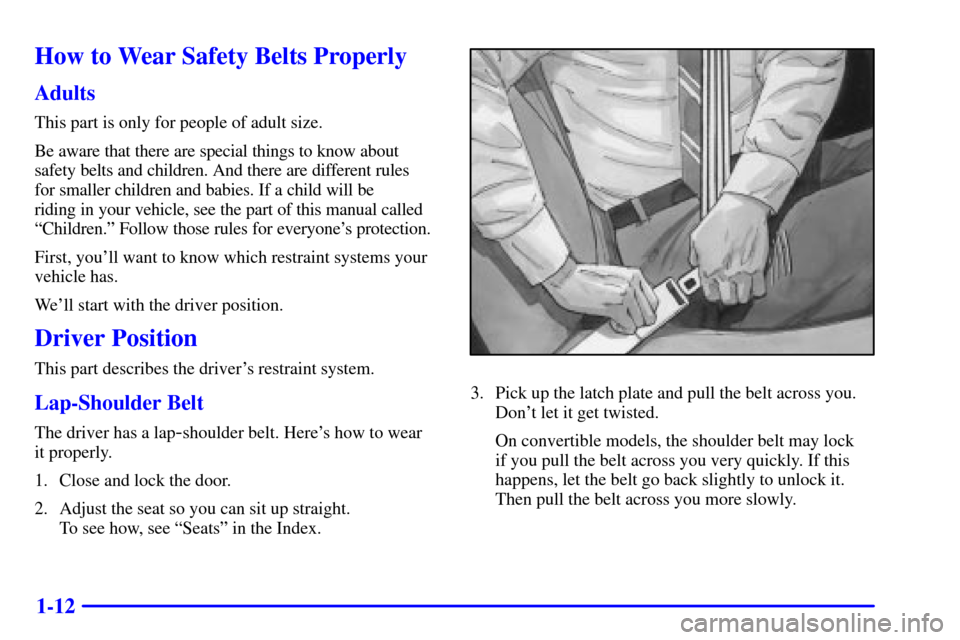
1-12
How to Wear Safety Belts Properly
Adults
This part is only for people of adult size.
Be aware that there are special things to know about
safety belts and children. And there are different rules
for smaller children and babies. If a child will be
riding in your vehicle, see the part of this manual called
ªChildren.º Follow those rules for everyone's protection.
First, you'll want to know which restraint systems your
vehicle has.
We'll start with the driver position.
Driver Position
This part describes the driver's restraint system.
Lap-Shoulder Belt
The driver has a lap-shoulder belt. Here's how to wear
it properly.
1. Close and lock the door.
2. Adjust the seat so you can sit up straight.
To see how, see ªSeatsº in the Index.
3. Pick up the latch plate and pull the belt across you.
Don't let it get twisted.
On convertible models, the shoulder belt may lock
if you pull the belt across you very quickly. If this
happens, let the belt go back slightly to unlock it.
Then pull the belt across you more slowly.
Page 25 of 363
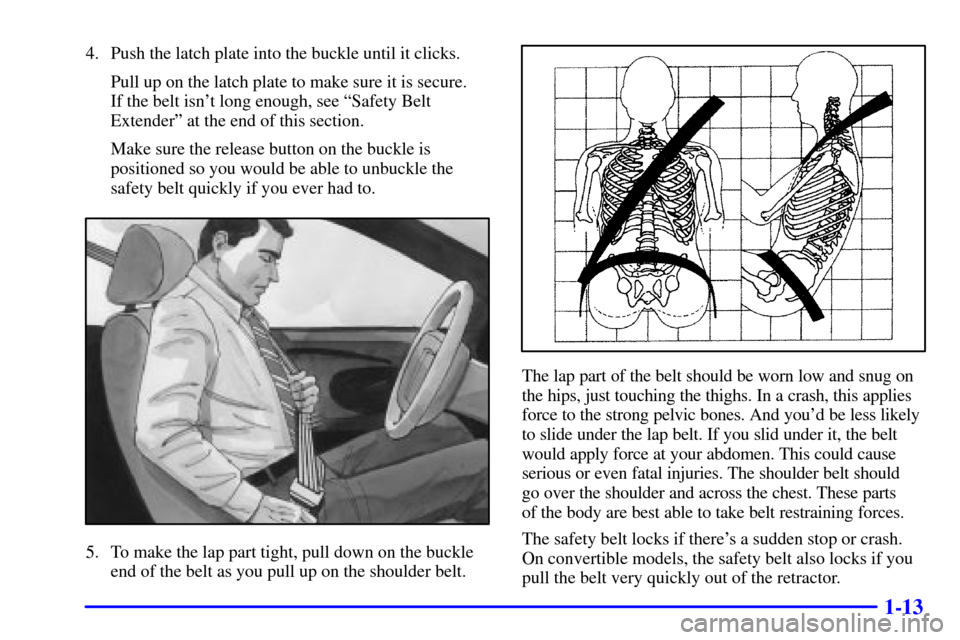
1-13
4. Push the latch plate into the buckle until it clicks.
Pull up on the latch plate to make sure it is secure.
If the belt isn't long enough, see ªSafety Belt
Extenderº at the end of this section.
Make sure the release button on the buckle is
positioned so you would be able to unbuckle the
safety belt quickly if you ever had to.
5. To make the lap part tight, pull down on the buckle
end of the belt as you pull up on the shoulder belt.
The lap part of the belt should be worn low and snug on
the hips, just touching the thighs. In a crash, this applies
force to the strong pelvic bones. And you'd be less likely
to slide under the lap belt. If you slid under it, the belt
would apply force at your abdomen. This could cause
serious or even fatal injuries. The shoulder belt should
go over the shoulder and across the chest. These parts
of the body are best able to take belt restraining forces.
The safety belt locks if there's a sudden stop or crash.
On convertible models, the safety belt also locks if you
pull the belt very quickly out of the retractor.